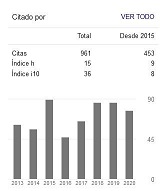In vitro Behavior of Enterotoxigenic Escherichia coli in Increasing Copper Concentrations.
Resumen
Cupric sulfate is widely used as growth promoter for swine productions, in spite of its ecological risks. The aim of this paper was to study the in vitro behavior of Enterotoxigenic Escherichia coli in increasing concentrations of copper. To achieve that, two reference strains: A-1 (O149: K91: K88ac) and E68-I (O141: K85: K88ab), were used with other four strains isolated from herds with colibacillosis. The reference strains were grown in Mueller-Hinton agar, according to the concentration gradient technique with weekly increasing values, from 5 to 50 mg/mL of CuSO4. The experiment lasted three weeks. Though in the initial contacts two wild strains were the best adapted, at the end all developed high tolerance to the metal. For A-1, it may be determined by the formation of biofilm, which, apart from the said resistance, is an important factor of virulence in infectious bacterial processes. The results observed are another element to add to the dangers of using these salts as growth promoters in swine productions.Descargas
Citas
BARRETO, G. (1988b). Una gran resistencia al antibiótico Aphramicyn en cepas de E. coli productoras de sulfuro de hidrógeno. Rev Prod. 4, 261-263.
BARRETO , G. y RODRÍGUEZ , H. (2006). Impacto del entorno en la virulencia bacteriana. Retrieved on January 9, 2015, from http://www.monografias.com/trabajos37/virulencia-bacteriana/virulencia-bacteriana 2.shtml.
BARRETO , G. y RODRÍGUEZ , H. (2009). La cápsula bacteriana, algo más que una estructura no esencial (Revisión). Revista de Prod. 21 (1), 69-80
BARRETO , G. y RODRÍGUEZ , H. (2010). Biofilms bacterianos versus antimicrobianos. Nutracéuticos: una opción promisoria (Artículo de revisión). Rev of Animal 22 (1), 20-30.
BARRETO , G.; RODRÍGUEZ , H.; BERTOT , J. A. y DELGADO , R. (2015). Microorganismos autóctonos multipropósitos (MAM) para el control y prevención de la colibacilosis neonatal porcina. Rev. Prod. Anim .27 (2), 16-19.
COOKSEY , D. A. (2006). Copper Uptake and Resistance in Bacteria. Molecular Microbiology, 7, 1-5.
MINSAP (2006). Formulario nacional de medicamentos. La Habana, Cuba: Editorial Ciencias Médicas.
DAVIES , P. R. (2011). Intensive Swine Production and Pork Safety. Foodborne Pathogens and Disease, 8 (2), 189-201.
HARRISON , J. J.; CERI , H. Y TURNER , R. J. (2007). Multimetal Resistance and Tolerance in Microbial Biofilms. Nat. Journal. Microbiol., 5 (12), 928-938.
HASTAD , C. W.; NELSSEN , J. L.; TOKACH , MICHAEL , D.; GOODBAND , R. D.; D RITZ , S. S. (2001). Evaluation of Different Copper Sources as a Growth Promoter in Swine Finishing Diets. Swine Day, 01, 111-117.
KARADJOV , J. (1985). Formation of an Exopolysaccharide Capsular Layer on the Surface of Some Bacteria Under the Influence of Pesticides and Heavy Metals. Cmtes rendus de l’ Académie Bulgare des Sciences, 38, 223-225.
MACÍAS , M.; DOMÍNGUEZ , P. L.; ABELEDO , C. M.; SOSA , R.; G ARCÍA , A.; C RUZ , E. et al. (2015). Manual de procedimientos técnicos para la crianza porcina. La Habana, Cuba: EDIPORC- Instituto de Investigaciones porcinas.
NAVES , P.; DEL PRADO , G.; HUELVES , L.; GRACIA , M.; RUIZ , V.; BLANCO , J. et al. (2008). Correlation between Virulence Factors and In Vitro Biofilm Formation by Escherichia coli Strains. Microbial Pathogenesis, 45 (2), 86-91.
REIS , A. C M.; SILVA , J. O.; LARANJEIRA , B. J.; PINHEIRO , A. Q. y CARVALHO , C. B. M. (2014). Virulence Factors and Biofilm Production by Isolates of Bacteroides fragilis Recovered from Dog Intestinal Tracts. Braz. J. Microbiol., 45 (2). Extraído el 9 de enero de 2015, desde http://dx.doi.org10.1590S1517-83822014000200037
RODRÍGUEZ , H.; BARRETO , G.; BERTOT , J. y VÁZQUEZ , R. (2013). Microorganismos eficientes como promotores del crecimiento en cerdos hasta el destete. REDVET. Revista electrónica de Veterinaria, 14 (9). Retrieved on January 9, 2015, from http://www.veterinaria.orgrevistasredvetn090913.html.[Consulted on March 15, 2015].
SEILER , C. y BERENDONK , T. U. (2012). Heavy Metal Driven Co-Selection of Antibiotic Resistance in Soil and Water Bodies Impacted by Agriculture and Aquaculture. Frontiers in Microbiology, 14 (3), 399. Retrieved on January 9, from http://www.ncbi.nlm.nih.gov/pubmed/23248620
Los autores de los artículos publicados en RPA retienen los derechos de autor de su trabajo, de marca y patente, y también sobre cualquier proceso o procedimiento descrito en el artículo, así como a compartir, copiar, distribuir, ejecutar y comunicar públicamente el artículo publicado en la RPA o cualquier parte de aquel siempre que indiquen la fuente de publicación (autores del trabajo, revista, volumen, número y fecha), pero están de acuerdo en que la revista publique los trabajos bajo una licencia Creative Commons.
![]() Licencia Attribution-NonCommercial 4.0 International (CC BY-NC 4.0)
Licencia Attribution-NonCommercial 4.0 International (CC BY-NC 4.0)






































